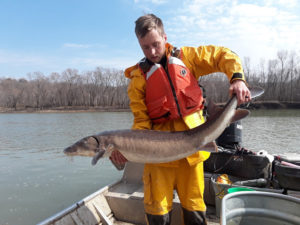2018 Student Writing Contest Winning Essay | Michael J. Moore
 1931 marked a new chapter in the Osage River’s history. A 148‐foot dam stretched across one of the Missouri River’s largest tributaries forming Lake of the Ozarks. Its concrete crest curled from bluff to bluff, looming over the depression‐era floodplain like a grin. The river transitioned to a future of cheap hydropower, luxury yachts, and phenomenal bass and crappie fishing. Despite all that was gained, the dam left behind memories of limestone bluffs, churning gravel shoals, and roiling spring runs of Walleye Sander vitreus and American Paddlefish Polyodon spathula. The Osage River was irrevocably altered, with nearly three‐fourths of its length permanently inaccessible to migratory fish downstream. Instantly, these fish became strangers in their own streams.
1931 marked a new chapter in the Osage River’s history. A 148‐foot dam stretched across one of the Missouri River’s largest tributaries forming Lake of the Ozarks. Its concrete crest curled from bluff to bluff, looming over the depression‐era floodplain like a grin. The river transitioned to a future of cheap hydropower, luxury yachts, and phenomenal bass and crappie fishing. Despite all that was gained, the dam left behind memories of limestone bluffs, churning gravel shoals, and roiling spring runs of Walleye Sander vitreus and American Paddlefish Polyodon spathula. The Osage River was irrevocably altered, with nearly three‐fourths of its length permanently inaccessible to migratory fish downstream. Instantly, these fish became strangers in their own streams.
One oft‐overlooked native migratory fish impacted by dams in Missouri is the Lake Sturgeon Acipenser fulvescens. By the 1970s, most Missouri residents had never seen one. Missouri’s Lake Sturgeon decline mirrors population collapses that led to 17 states and Canadian provinces listing Lake Sturgeon as threatened or endangered. Today, citizens are often surprised that a fish with “lake” in its name was abundant in the state’s large rivers or that Lake Sturgeon depend on free‐flowing rivers. Each spring they migrate up to 150 km in search of rocky shoals to spawn. Populations of this slow‐growing species are sensitive to harvest, especially when combined with habitat and water quality degradation. Despite their relative anonymity in modern Missouri, Native American tribes, caviar connoisseurs, and anglers revere sturgeon. In Wisconsin, spear anglers sit in dark ice shacks waiting for a gray zeppelin to appear out of the murky darkness. Festivals celebrating sturgeon have sprung up in cities like Milwaukee. The loss of the iconic fish, with its whisker‐like barbels and bony scutes, was a devastating blow to the conservation heritage of the region.
However, the Lake Sturgeon’s future is bright. Since the 1980’s, the Missouri Department of Conservation has stocked 6‐month‐old sturgeon from Wisconsin. Lake Sturgeon populations are rebounding with a proportion reaching sexual maturity. Nevertheless, Missouri Lake Sturgeon are not safe yet. Unanswered questions remain about the ecology of southern Lake Sturgeon in altered rivers that impede conservation decision‐making. Furthermore, studying Lake Sturgeon at its southern range margin offers clues to how this cool‐water fish will fare further north as waters warm. Documenting consistent reproduction of Lake Sturgeon in the Missouri River tributaries would free resources for other important conservation issues.
Therefore, with the support of the Missouri Department of Conservation, we are studying Lake Sturgeon movement and habitat use in two Missouri River tributaries. By comparing movement patterns and habitat use of Lake Sturgeon in the dammed Osage River, and the undammed Gasconade River, we can determine how Lake Sturgeon are responding to changing habitats.
To accomplish this, we surgically implanted 93 Lake Sturgeon, 66 in the Osage and 27 in the Gasconade with acoustic telemetry tags. These tags—no bigger than a baby carrot—are inserted into a fish’s abdominal cavity. The tags “ping” high frequency soundwaves every 60–90 s. We track these pings and record a fish’s location using anchored receivers and boat‐mounted microphones.
So far, we discovered that tributaries are important year‐round habitats for Lake Sturgeon, which spend 75% of their time there. Lake Sturgeon appear to be more abundant in the Osage River than the Gasconade River. Although the Osage is larger, it may also provide important habitat or food resources. With the additional 23 sturgeon we tagged in the Gasconade this spring, we will be able to compare habitat use and spawning migrations in the two rivers. Movement rates are highest in the spring and fall. In the summer and winter, Lake Sturgeon aggregate in deep pools. Closer examination of habitat use in these seasons will help us determine whether they provide a limited resting refuge during stressful warm or cold periods. With dam construction, channelization, and climate change, a Lake Surgeon from the early 1900s might have difficulty recognizing modern Missouri rivers. However, our research of Lake Sturgeon will assist managers in their efforts to create conditions that make these reintroduced fish feel right at home. In the process, perhaps we can not only reintroduce Lake Sturgeon to Missouri, but also reacquaint Missourians with one of their largest and most distinctive fish.


 1931 marked a new chapter in the Osage River’s history. A 148‐foot dam stretched across one of the Missouri River’s largest tributaries forming Lake of the Ozarks. Its concrete crest curled from bluff to bluff, looming over the depression‐era floodplain like a grin. The river transitioned to a future of cheap hydropower, luxury yachts, and phenomenal bass and crappie fishing. Despite all that was gained, the dam left behind memories of limestone bluffs, churning gravel shoals, and roiling spring runs of Walleye Sander vitreus and American Paddlefish Polyodon spathula. The Osage River was irrevocably altered, with nearly three‐fourths of its length permanently inaccessible to migratory fish downstream. Instantly, these fish became strangers in their own streams.
1931 marked a new chapter in the Osage River’s history. A 148‐foot dam stretched across one of the Missouri River’s largest tributaries forming Lake of the Ozarks. Its concrete crest curled from bluff to bluff, looming over the depression‐era floodplain like a grin. The river transitioned to a future of cheap hydropower, luxury yachts, and phenomenal bass and crappie fishing. Despite all that was gained, the dam left behind memories of limestone bluffs, churning gravel shoals, and roiling spring runs of Walleye Sander vitreus and American Paddlefish Polyodon spathula. The Osage River was irrevocably altered, with nearly three‐fourths of its length permanently inaccessible to migratory fish downstream. Instantly, these fish became strangers in their own streams.


